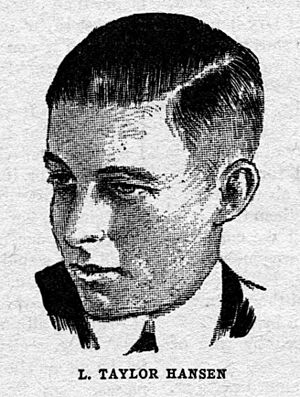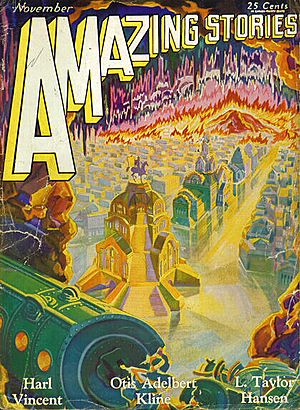L. Taylor Hansen facts for kids
Quick facts for kids
Lucile Taylor Hansen
|
|
|---|---|
| Born | November 30, 1897 |
| Died | May 1976 |
| Nationality | American |
| Citizenship | US |
| Scientific career | |
| Fields | Writer |
Lucile Taylor Hansen (born November 30, 1897 – died May 1976) was a talented American writer. She wrote exciting science fiction stories and many articles about popular science. For some of her early work, she used a male name to publish her stories. She wrote eight short stories, almost sixty non-fiction articles about anthropology (the study of human societies and cultures) and geology (the study of Earth's physical structure), and three non-fiction books.
Her Early Life and Interests
Lucile Taylor Hansen remembered living in an old fort with her parents when she was young. In 1919, she became part of an Ojibwe tribe. This happened after she suggested they talk to government officials instead of fighting. From then on, she spent her life studying Native American legends and stories.
She also took classes at the University of California, Los Angeles in the 1920s. However, she did not finish a degree there.
Exploring Science and History
Starting in 1941, Hansen wrote a regular column called "Scientific Mysteries" for Amazing magazine. She wrote nearly sixty articles for this column until 1948. Her first article discussed her father's ideas about continental drift. This is the idea that Earth's continents have moved over long periods. She looked at different opinions and showed evidence that supported the theory. This included how rocks and animals on different continents seemed connected. She believed that scientists working together could "push back the veils of mystery" and learn from the past. This series of articles led her to explore how different stories from the Americas might have similar beginnings.
Hansen was not afraid to discuss big topics in anthropology. She challenged old ideas about how different groups of people were seen. For example, in a 1942 article, she said that judging people by their skin color was "far too superficial." She pointed out that the shape of a person's skull, like those of the Mayans, did not affect their intelligence. She helped show that old ideas about race were wrong.
Later, Hansen started using different pen names. An article called "America's Mysterious Race of Indian Giants" appeared in Amazing in 1946. Even though it sounded like Hansen's writing, it was credited to "Chief Sequoyah." Another story by Chief Sequoyah appeared in 1948. She also wrote a story called "The Fire-Trail" under the name Oge-Make. This name was said to be from a Navaho person. She even wrote about "Flying Saucers" under the Oge-Make name in another magazine.
As she finished her studies of Native American legends, Hansen published three non-fiction books. Her first book, Some Considerations of and Additions to the Taylor-Wegener Hypothesis of Continental Displacement (1946), explained the continental drift theory. Her second book, He Walked the Americas (1963), collected many Native American legends about a light-skinned prophet. Her last book, The Ancient Atlantic (1969), explored the culture and geography of the Atlantic Ocean, including the legend of Atlantis.
In He Walked the Americas, Hansen shared many Native American legends and folklore about a "White Prophet" who visited different parts of America. Some Mormons have found this book interesting because it connects to their beliefs about ancient Christianity in the Americas.
Her Science Fiction Stories

Lucile Hansen's science fiction writing career was short, but she was one of the first women to write in a genre mostly written by men. Her first story, "What the Sodium Lines Revealed," came out in 1929. This story was an adventure that used scientific ideas. It was about an amateur astronomer who found a message in light from space. That same year, her story "The Undersea Tube" described an underground city found while building a train tunnel between New York and Liverpool.
Some people believe that Hansen tried to hide that she was a woman. An illustration of a young man, supposedly Hansen, even appeared with one of her stories. She also told a fan on the phone that she wasn't the author, but just handled the stories for her brother. Some think she did this because women writers were not as common in science fiction back then. She might have wanted to avoid social disapproval.
However, others say that Hansen was just a private person. The editor of Amazing Stories magazine, Raymond A. Palmer, often published stories by women. This suggests that he was open to working with female authors.


